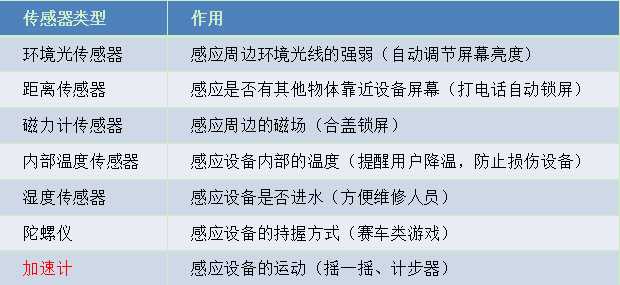标签:
iPhone自带很多传感器,常见的如下表所示:

系统针对各种sensor都有相应的使用方法,eg: 距离传感器使用
// 开启距离感应功能 [UIDevice currentDevice].proximityMonitoringEnabled = YES; // 监听距离感应的通知 [[NSNotificationCenter defaultCenter] addObserver:self selector:@selector(proximityChange:) name:UIDeviceProximityStateDidChangeNotification object:nil]; - (void)proximityChange:(NSNotificationCenter *)notification { if ([UIDevice currentDevice].proximityState == YES) { NSLog(@"某个物体靠近了设备屏幕"); // 屏幕会自动锁住 } else { NSLog(@"某个物体远离了设备屏幕"); // 屏幕会自动解锁 } }
设备型号、CPU情况、内存使用情况、硬盘使用情况 ...
是否越狱、装了哪些传感器、当前运行的进程 ...
有2种方法获取更多的设备信息
导入底层的C语言库,通过底层的C语言函数获取(较复杂,需要很多时间去研究)
使用第三方库(用OC封装了底层的C函数)
https://github.com/Shmoopi/iOS-System-Services
https://github.com/erica/uidevice-extension
》加速计可以用来检测设备的运动,摇一摇/计步器等常见应用都是基于加速计实现的。
》加速计主要通过:检测设备在X、Y、Z轴上的加速度 (哪个方向有力的作用,哪个方向运动了),根据加速度数值,就可以判断出在各个方向上的作用力度
》加速计的开发主要有两种方式:
使用UIAccelerometer,用法非常简单(到了iOS5就已经过期)
从iOS4开始:CoreMotion.framework
1、获取单例对象
UIAccelerometer *accelerometer = [UIAccelerometer sharedAccelerometer];
2、设置代理
accelerometer.delegate = self;
3、设置采样间隔
accelerometer.updateInterval = 1.0/30.0; // 1秒钟采样30次
4、实现代理方法
- (void)accelerometer:(UIAccelerometer *)accelerometer didAccelerate:(UIAcceleration *)acceleration // acceleration中的x、y、z三个属性分别代表每个轴上的加速度
》iOS4中对加速计进行了全面升级,引入陀螺仪;增加了专门处理motion的框架CoreMotion.framework
Core Motion不仅能够提供实时的加速度值和旋转速度值,更重要的是,苹果在其中集成了很多牛逼的算法
》CoreMotion获取数据的两种方式
push:实时采集所有数据(采集频率高)-采集方式跟UIAccelerometer一样
pull:在有需要的时候,再主动去采集数据
》push的开发步骤
// 1.创建coreMotion管理者 // CMMotionManager *mgr = [[CMMotionManager alloc] init]; self.mgr = [[CMMotionManager alloc] init]; // 2.判断加速计是否可用 if (self.mgr.isAccelerometerAvailable) { /* isAccelerometerActive 是否正在采集 accelerometerData 采集到得数据 startAccelerometerUpdates pull startAccelerometerUpdatesToQueue push stopAccelerometerUpdates 停止采集 accelerometerUpdateInterval 采样时间 */ // 3.设置采样时间 self.mgr.accelerometerUpdateInterval = 1 / 30.0; // 4.开始采样 [self.mgr startAccelerometerUpdatesToQueue:[NSOperationQueue mainQueue] withHandler:^(CMAccelerometerData *accelerometerData, NSError *error) { // 这个block是采集到数据时就会调用 if (error) return ; CMAcceleration acceleration = accelerometerData.acceleration; NSLog(@"x = %f y = %f z = %f", acceleration.x, acceleration.y , acceleration.z); }]; }else { NSLog(@"加速计不可用"); }
》pull的开发步骤
//创建运动管理者对象 CMMotionManager *mgr = [[CMMotionManager alloc] init]; //判断加速计是否可用 if (mgr.isAccelerometerAvailable) { // 加速计可用 } //开始采样 - (void)startAccelerometerUpdates; //在需要的时候采集加速度数据 CMAcceleration acc = mgr.accelerometerData.acceleration; NSLog(@"%f, %f, %f", acc.x, acc.y, acc.z);
监控摇一摇的方法
方法1:通过分析加速计数据来判断是否进行了摇一摇操作(比较复杂)
方法2:iOS自带的Shake监控API(非常简单)
判断摇一摇的步骤:实现3个摇一摇监听方法
- (void)motionBegan:(UIEventSubtype)motion withEvent:(UIEvent *)event /** 检测到摇动 */ - (void)motionCancelled:(UIEventSubtype)motion withEvent:(UIEvent *)event /** 摇动取消(被中断) */ - (void)motionEnded:(UIEventSubtype)motion withEvent:(UIEvent *)event /** 摇动结束 */
标签:
原文地址:http://www.cnblogs.com/shanhua/p/4781501.html